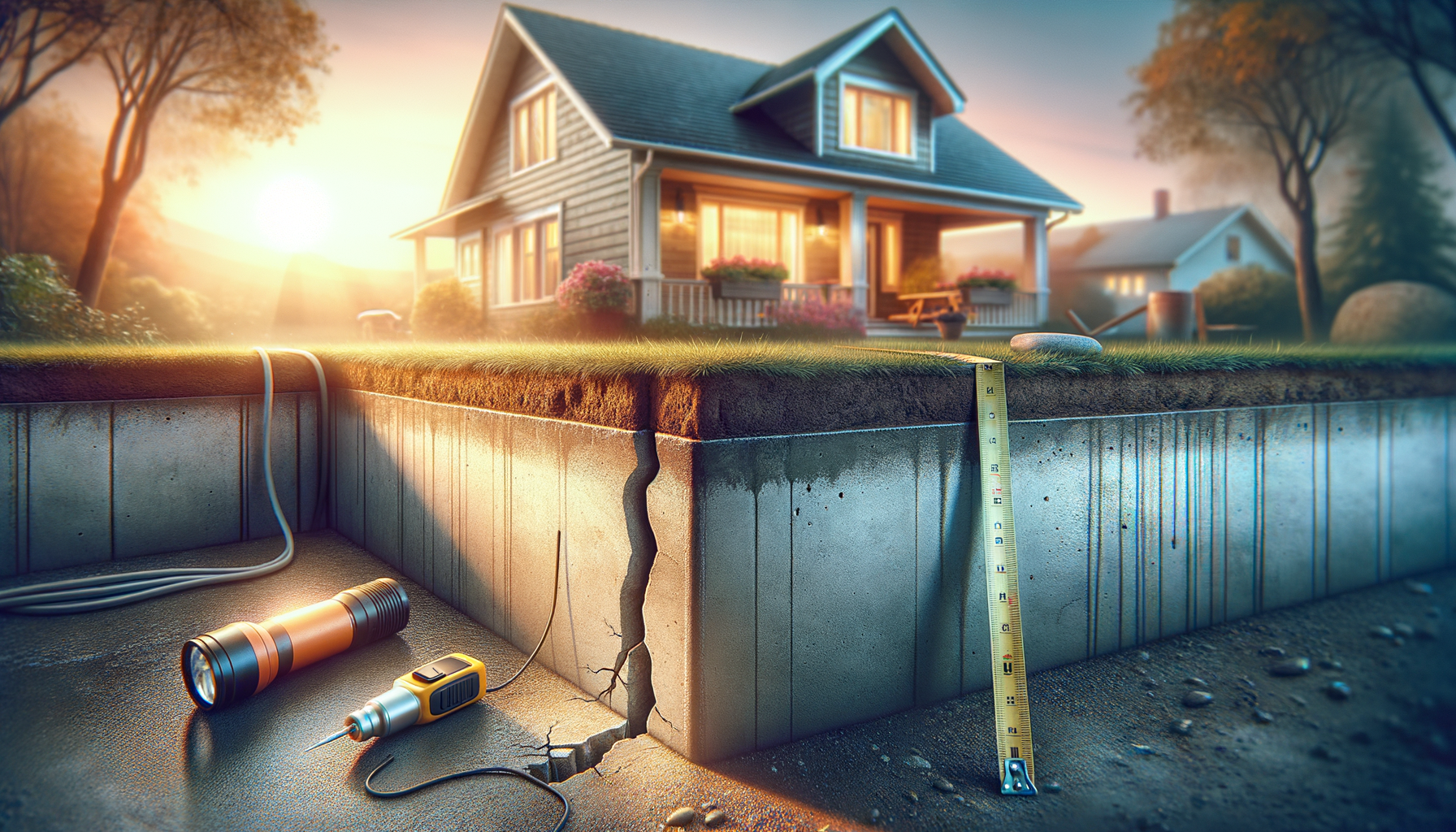Keywords: foundation inspection, foundation repair, foundation types, signs of foundation problems, professional foundation services
Understanding Your Foundation
Types of Foundations
- Concrete Slab Foundation: Often found in newer homes; a single layer of concrete that’s a few inches thick.
- Crawlspace Foundation: Raised a bit above the ground, leaving space under the house for things like plumbing.
- Basement Foundation: A full or partial floor below ground level; can be used as extra living space but needs more care.
Why a Strong Foundation Matters
- Keeps Your Home Safe: A solid foundation keeps your house stable.
- Stops Water Problems: Good foundations help keep water out, preventing mold and rot.
- Saves Money Over Time: Fixing small issues early can stop big, expensive repairs later.
Signs Your Foundation Needs Inspection
Visible Cracks
- Horizontal vs. Vertical Cracks: Horizontal cracks can be serious. Vertical cracks are usually less of a worry.
- Small vs. Large Cracks: Tiny cracks might not be a problem, but big ones could mean trouble.
Uneven Floors
- Sloping or Sagging: Floors that dip or slope can indicate issues.
- Sticking Doors and Windows: Doors and windows that are hard to open might be a sign of foundation problems.
Water Problems
- Persistent Wet Spots: Ongoing dampness can weaken your foundation.
- Mold and Mildew: These can mean there’s too much moisture around your foundation.
Sinking or Settling
- Gaps Around Windows and Doors: Uneven settling can cause gaps.
- Separation from Walls: Gaps between walls and floors or ceilings can signal serious settling issues.
Doing a DIY Foundation Inspection
Tools You Might Need
- Flashlight
- Level
- Measuring Tape
Step-by-Step Guide
- Walk Around Your Home: Look for cracks or gaps in the foundation outside.
- Check Inside Your Basement or Crawlspace: Look for similar signs inside.
- Inspect Foundation Walls: Pay attention to any changes over time.
- Look for Signs Inside: Notice uneven floors, sticking doors/windows, and wall cracks.
When to Call the Professionals
How Bad Is It?
- Small Cracks vs. Big Issues: You might manage small cracks, but big problems need expert help.
Special Tools and Knowledge
- Know the Local Conditions: Pros understand how the local soil affects foundations.
- Advanced Equipment: Tools like laser levels and hydraulic jacks help them diagnose problems accurately.
Peace of Mind
- Expert Assessment: Pros give accurate evaluations and effective solutions.
- Repair Warranties: Professional repairs often come with guarantees, protecting your investment.
Common Foundation Repair Methods
Crack Repair
- Epoxy Injection: Fixes cracks in concrete foundations.
- Polyurethane Foam: Expands inside cracks to seal them.
Underpinning
- Push Piers: Lift the foundation by driving piers into stable soil.
- Helical Piers: Screwed into the ground for support.
Slabjacking
- Mudjacking: Lifts the foundation by pumping a grout mixture below it.
- Foam Injection: Uses high-density foam for a similar purpose.
Waterproofing
- Exterior Waterproofing: Applies sealant outside foundation walls.
- Interior Sealants: Uses a waterproof coating inside the basement.
How to Keep Your Foundation Healthy
Maintain Good Drainage
- Clear Gutters and Downspouts: Keeps water from collecting around the foundation.
- Slope Soil Away from the Foundation: Ensures water flows away from your home.
Control Moisture Levels
- Use a Dehumidifier: Keeps indoor humidity controlled.
- Vapor Barriers in Crawlspaces: Stops ground moisture from coming in.
Regular Checks and Maintenance
- Annual Inspections: Look over your foundation at least once a year.
- Fix Issues Quickly: Handle new cracks or other signs of damage right away.
Foundation Repair Costs
Cost Factors
- Severity of the Issue: More serious problems cost more to fix.
- Type of Repair: Different methods have different costs.
- Location: Repair costs can vary by region.
Average Costs in Canada
- Crack Repairs: $500 to $2,500.
- Underpinning: $1,000 to $3,000 per pier.
- Full Foundation Replacements: Over $20,000.
Finding a Reliable Repair Company
Research and Reviews
- Check Online Reviews: Sites like Google and Yelp can help.
- Ask Friends and Family: Personal recommendations are often trustworthy.
Certifications and Experience
- Licensed and Insured: Make sure they have the proper credentials.
- Experience and Training: Experienced contractors often provide better service.
Important Questions to Ask
- Warranties and Guarantees: Ensure they offer reliable warranties.
- Written Estimates: Get clear and detailed quotes to avoid surprises.
Homeowner’s Checklist for Foundation Health
Regular Visual Inspections
- Monthly Checks: Look for foundation issues often.
- Seasonal Inspections: Do more thorough checks as the seasons change.
Track Changes
- Record Cracks or Changes: Keep track of any new cracks or shifts in your foundation.
- Note New Issues Quickly: Address new or worsening problems right away.
Routine Maintenance
- Ensure Good Drainage: Keep water away from your foundation.
- Fix Minor Issues Quickly: Small repairs now can stop big problems later.
Taking the time to inspect and repair your home’s foundation can save you a lot of trouble and money in the future. By following these tips and knowing when to call in the pros, you can ensure your home stays strong and safe for years to come.


Leave a Reply